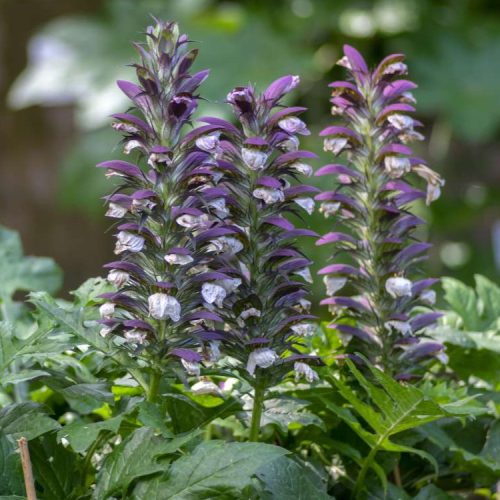Acanthus
The handsome foliage and flowers of Acanthus or Bear’s Breeches make a dramatic statement in a large herbaceous border. Our Acanthus plants are 100% pesticide-free and are perfect for organic gardening.
This easy-to-grow, long-lived perennial is valued for its glossy, rich green foliage. And as a bonus, bees and other pollinators adore the tall, stately columns of flowers, each with a pink or purple hood over a white lip. There’s a cultivar to suit every garden – some grow tall and spread while others are compact and well-suited to a smaller plot.
Showing the single result
Showing the single result
Acanthus in history
The architectural foliage of Acanthus inspired the sculptors of ancient Greece and Rome, who used stylised Acanthus motifs to decorate the top of Corinthian columns. Acanthus decoration was also used in interiors and on clothing.
Ancient physicians valued Acanthus and used the roots to make a plaster to heal dislocated joints and burns. Acanthus leaves contain mucilage and tannin and were thought to heal internally, so an infusion of Acanthus was used as a diuretic, to treat spasms and to soothe the nerves.
Planting
Plant Acanthus in well-drained soil in early autumn or spring. In the wild, Acanthus is mainly found along the eastern Mediterranean coast and into Turkey, where it grows on dry, stony hills. Most varieties love a sunny spot, although they also thrive in light shade at the edge of a woodland planting. Once the roots are fully developed, Acanthus is tolerant of drought and salt, so it’s an excellent option for a seaside garden.
Acanthus grows to around 80cm to 1.5 metres tall, so it’s ideal for the middle or back of a border. For smaller spaces, it’s fantastic as an accent plant in tubs and containers.
Powdery mildew can be a problem in hot, dry conditions. Avoid planting in deep shade or in soil that gets soggy, as Acanthus doesn’t like sitting in water, especially in winter. The young plants are a favourite with slugs and snails, so watch out for damage in spring. Acanthus forms large clumps that can survive for many years.
It spreads easily as it propagates both by self-seeding and from any portions of root that may be left behind if you move the plants. So plant Acanthus where you want it permanently, as once it’s established, it’s quite a challenge to eradicate!

